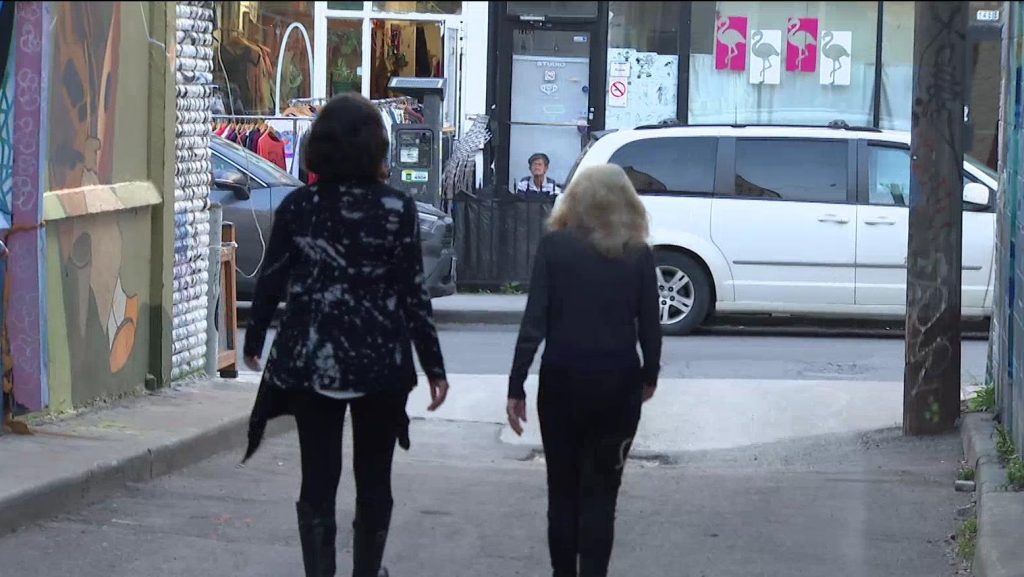Fight over replacing Toronto’s planetarium continues between U of T and Queen’s Park Coalition
Posted October 30, 2020 6:52 am.
Last Updated October 30, 2020 8:38 am.
The fight over what replaces Toronto’s landmark McLaughlin Planetarium continues as neighbourhood groups and the University of Toronto square off at City Hall.
At the centre of the debate are plans for a new building, which would go on the planetarium’s site at 90 Queen’s Park, next to the Royal Ontario Museum, and just north of the Ontario legislature.
Current designs for the building, which have already been revised based on community feedback, are being panned by locals.
“It was the wrong building in the wrong place,” says Bronwyn Krog, of the Queen’s Park Coalition, which is made up of eight local residents’ groups. “It would have been entirely suitable on another city street or at the Mississauga or Scarborough campuses, but not here in this location.”
“That’s very privileged location in the city and it needs to be an extraordinary project”
She says the group doesn’t object to the building itself, but that it’s not appropriate for such an iconic location. They would rather see something similar in design, materials and style to other recent additions to the area, such as the Gardiner Museum. Queen’s Park Coalition has also been concerned about the building’s height, and the impact to the mature tree canopy.
“The size and scale of the building was just completely wrong for the location, it would have always been forever been a blot on the landscape of Queens Park, and it could have set up quite a dangerous precedent,” says Krog.
The University of Toronto has owned the planetarium since 2009, when it bought the property from the ROM for $22 million. The new building proposed for the property would house faculty offices, labs and work spaces, including a music hall.
It would stand 43 metres tall and also take up the space next door. Falconer Hall is considered a heritage building so portions would be preserved while more would be added above.
“That’s very privileged location in the city and it needs to be an extraordinary project,” says Peter Clewes, partner at architectsAlliance. His firm, along with a New York-based team, have been working on the project for about five years.
“What we think we’ve achieved is a careful balance of all the various sometimes competing objectives, and so it’s a building that really comes out of that process,” says Clewes, noting that the building design is now shorter than in its original plans, due to public feedback.
A few years ago, objections to the project centred around saving the distinctive planetarium building from being demolished.
“We need to think about what we can keep, what we can repurpose”
The McLaughlin Planetarium opened in 1968. Its large white dome was a gift to the ROM and Ontario citizens, from former General Motors chairman R.S. McLaughlin of Oshawa.
It cost $2.25 million to build and its main attraction was the Star Theatre, where thousands of stars, planets, the sun and moon were all projected inside as part of regular shows for visitors.
The destination, though, ran its course and actually closed in 1995, meaning it has been closed for nearly as long as it welcomed visitors.
“We need to evolve,” says Andrew Pruss, principal at ERA Architects. “We need to think about what we can keep, what we can repurpose, and then what we can add to, you know that cultural resource that that’s already there.”
Buildings along the stretch of road between Queen’s Park Crescent – to the north of the legislature – and Bloor Street all carry a sense of history.
Queen’s Park itself was built in 1860. Some buildings in the area started off as private homes, built in the mid-1800s, while other additions date to the 1930s and 1960s.
Many have ties to the University of Toronto, including Victoria and Emmanuel Colleges to the east, and the university’s Jackman Law building, which opened four years ago.
“This is a pretty iconic strip in the city of Toronto, one whose landscape with buildings and without has stood the test of time, over, over hundreds of years,” says Councillor Mike Layton, who represents the riding of University-Rosedale. He adds that heritage experts looked at the existing building and determined it wouldn’t be practical to re-purpose it for future use.
The site has been a source of controversy for over a decade. While still owned by the ROM, there was a proposal for a 46-storey condo building.
With the latest version, city hall has opted to hold off on making a decision to approve or reject the plan, in order to study the cultural heritage landscape of the area. Krog says the study is an important step in conserving the historic district, which currently has few protections. The university is appealing the decision.
“No one looked at Queen’s Park,” when doing other heritage evaluations, Layton says. “It would be a shame if we really are altered that landscape without some serious consideration as to what we wanted it to become.”
He says that residents, students and designers spent nearly a year in working groups, making changes to the designs.
“To our credit we did made some changes to the proposal,” he says, “but still a fundamental issue was how the scale of the building would ultimately impact […] this street for the long-term.”
Clewes says the design team is taking public feedback seriously.
“It is a process,” he says. “We hope in the fullness of time that we’ll all come together and have a project that everybody can support.”










